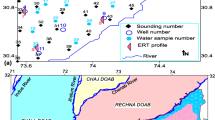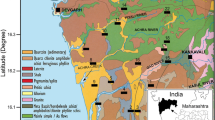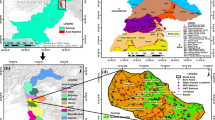Abstract
Delineation of saline water and freshwater interfaces is a primary objective in groundwater studies and groundwater management. Karak valley, NW Himalaya of Pakistan is situated in a semiarid region where the continuous supply of freshwater is challenging because of high salinity values in groundwater. In this study, vertical electrical resistivity and borehole data are used to mark the freshwater and saline water interfaces. Borehole data collected from different locations in the study area is used to interpret various subsurface lithologies and to calibrate the modeled resistivity curves. The electrical resistivity data indicates that a thick cover of Quaternary sediments is present in the valley. The re-inversion of electrical resistivity data with modern analysis techniques is highly effective to map the boundary between fresh and saline water aquifers in the valley. Inversion technique is applied to generate 2D and 3D subsurface resistivity maps for the delineation of fresh and saltwater surfaces. The presence of saline water aquifer with clay rich sediments is identified by very low resistivity values on the northern part of the valley whereas relatively high resistivity values with sand and gravel sediments on the southeastern part of the valley indicate the presence of freshwater aquifer. The generated 2D resistivity surface maps at different depth levels above and below the water table and formation resistivity distribution map are effectively used to mark the boundary between fresh and saline water zones. The zone of brackish water is clearly seen in the resistivity inverse model at a depth of 5–30 m.











Similar content being viewed by others
References
Abdullahi NK, Osazuwa IB, Sule PO (2011) Application of integrated geophysical technique in the investigation of groundwater contamination: a case study of municipal solid waste leachate. Ozean. J Appl Sci 4:7–25
Adeoti L, Alilie OM, Uchegbulam O (2010) Geophysical investigation of saline water intrusion into freshwater aquifers; a case study of Oniru, Lagos state. Sci Res Essays 5:248–259
Armada LT, Dimalanta CB, Yumul GP Jr, Tamayo RA Jr (2009) Georesistivity signature of crystalline rock in the Romblon Island Group, Philippines. Philippine J Sci 138:191–204
Barlow PM (2003) Ground water in fresh water-salt water environments of the Atlantic Coast (Circular; 1262) U.S. Geological Survey, Reston, Virginia.
Barlow PM, Reichard EG (2010) Saltwater intrusion in coastal regions of North America. Hydrogeol J. 18(1):247–260
Enikanselu PA (2008) Detection and monitoring of dumpsite-induced groundwater contamination using electrical resistivity method. Pac J Sci Technol 9:254–262
Farid A, Jadoon K, Akhter G, Iqbal MA (2013) Hydrostratigraphy and hydrogeology of the western part of Maira area, Khyber Pakhtunkhwa: a case study by using electrical resistivity. Environ Monit Assess 185(3):2407–2422
Ghumman AR, Sultan T, Hashmi HN, Rizwan A (2014) Investigation of groundwater quality for irrigation in Karak District. Technical Journal, University of Engineering and Technology Taxila, 19 (1).
Hassan S, Ahmed I, Mahmood K, Ali J, Abbas S (2014) Evaluation of drinking water for heavy metals of District Karak, Khyber Pakhtunkhwa. World Appl Sci J 30(4):402–405
Hodlur GK, Dhakate R, Sirisha T, Panaskar DB (2010) Resolution of freshwater and saline water aquifers by composite geophysical data analysis methods. Hydrol Sci J 55(3):414–434
IPI2WIN-1D computer programme (2000) Programs set for 1- D VES data interpretation. In: Moscow: Department of Geophysics. Geological Faculty, Moscow University
K’Orowe MO, Nyadawa MO, Singh VS, Ratnakar D (2011) Hydrogeophysical parameter estimation for aquifer characterisation in hard rock environments: a case study from Jangaon sub-watershed, India. J Oceanogr Mar Sci 2:50–62
Kruseman GP, Naqavi SAH (1988) Hydrogeology and groundwater resources of the Northwest Frontier Province Pakistan. WAPDA Hydrogeology Directorate Peshawar, Pakistan, p 191
MacDonald AM, Davies J, Dochartaigh BÉ (2001) Simple methods for assessing groundwater resources in low permeability areas of Africa. British Geological Survey, Nottingham, p 71
Malik MY, Jousma G (1984) Groundwater resources in Karak Valley, WAPDA Hydrogeology Directorate Peshawar. Technical Report No. IV-2, p 31.
Nwankwo LI (2011) 2D resistivity survey for groundwater exploration in a hard rock terrain: a case study of MAGDAS observatory, UNILORIN, Nigeria. Asian J Earth Sci 4:46–53
Paracha W, Kemal A, Abbasi F (2000) Kohat Duplex in Northern Potwar Deformed Zone, Pakistan. Geol Surv Pakistan Geological 5:99–107
Parsekian AD, Singha K, Minsley BJ, Holbrook WS, Slater L (2015) Multiscale geophysical imaging of the critical zone. Rev. of. Geophysics 53:1–26
Searle MP, Khan MA, Jan MQ, DiPietro JA, Pogue KR, Pivnik DA, Sercombe Izatt WJ, Blisniuk CN, Treloar PM, Gaetani PJ, Zanchi A (1996) Geological map of north Pakistan and adjacent areas of northern Ladakh and Western Tibet. Salt Ranges, Kohistan, Karakoram and Hindi Kush: Western Himalaya, prepared from map sheets G-6B, G-6C, G-7A, G-7D, Scale: 1:650,000. Oxford University, Oxford
Sikandar P, Bakhsh A, Arshad M, Rana T (2010) The use of vertical electrical sounding resistivity method for the location of low salinity groundwater for irrigation in Chaj and Rachna Doabs. Environ Earth Sci 60(5):1113–1129
Sultan SA, Mekhemer HM, Santos FM (2009) Geophysical measurements for subsurface mapping and groundwater exploration at the central part of the Sinai Peninsula, Egypt. Arab J Sci Eng 34(1A):103–119
Tam VT, Batelaan O, Le TT, Nhan PQ (2014) Three-dimensional hydrostratigraphical modelling to support evaluation of recharge and saltwater intrusion in a coastal groundwater system in Vietnam. Hydrogeol J. 22(1):1749
Ugwu SA, Nwosu JI (2009) Effect of waste dumps on groundwater in choba using geophysical method. J Applied Sci. Environ Manage. 130:85–89
Waller RM (1988) Ground water and the rural homeowner: general interest publication of the U.S. Geol Surv:37
Zananiri I, Memou T, Lachanas G (2006) Vertical electrical sounding (VES) survey at the central part of Kos Island, Aegean, Greece. Geosciences:411–413
Zektser IS, Everett LG (2004) Groundwater resources of the world and their use, IHP-VI Ser. Groundwater 6, U. N. Educ., Sci. and Cultural Organ., Paris.
Author information
Authors and Affiliations
Corresponding author
Rights and permissions
About this article
Cite this article
Khalid, P., Ullah, S. & Farid, A. Application of electrical resistivity inversion to delineate salt and freshwater interfaces in quaternary sediments of northwest Himalaya, Pakistan. Arab J Geosci 11, 112 (2018). https://doi.org/10.1007/s12517-018-3471-0
Received:
Accepted:
Published:
DOI: https://doi.org/10.1007/s12517-018-3471-0




